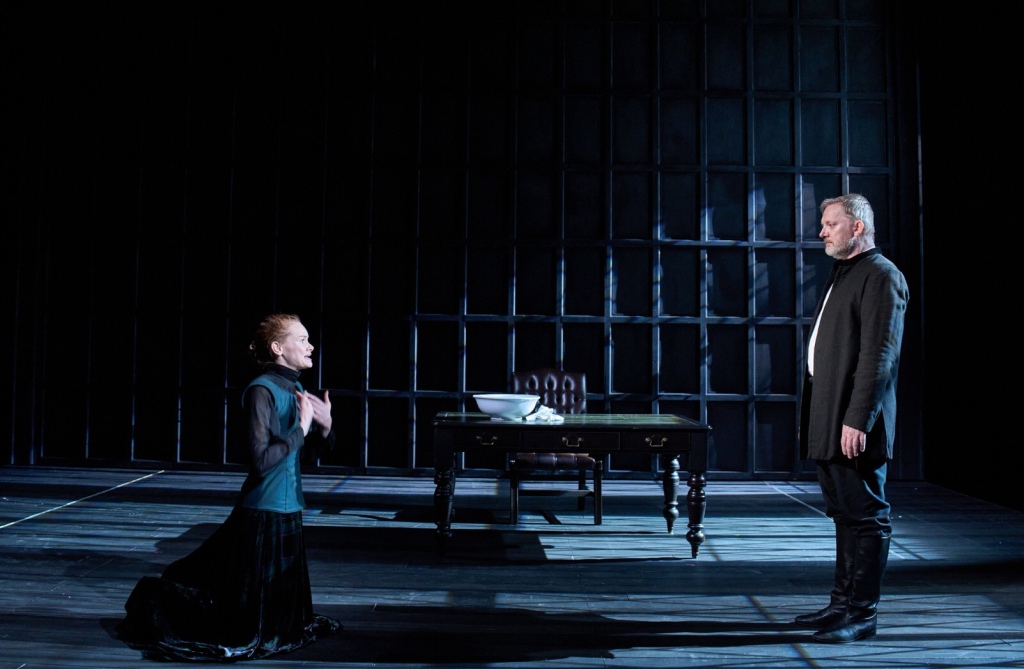
MARY
by Rona Munro
directed by Roxana Silbert
Hampstead Theatre – until 26 November 2022
https://www.hampsteadtheatre.com/
The titular Mary of Rona Munro’s brief but absorbing new play is the 16th century Queen of Scots, a fascinating figure whose short, controversial life has already provided rich dramatic fodder for playwrights such as Schiller (the oft-revived Mary Stuart), Robert Bolt (the epic pageant Vivat Vivat Regina), and Liz Lochhead with the bracingly political Mary Queen of Scots Got Her Head Chopped Off. Although, like Lochhead, Munro comes at Mary’s legend from a distinctly Scottish angle (it’s a companion piece to the same writer’s acclaimed The James Plays cycle, which in modern terms does for Scotland’s history what Shakespeare did for England’s), her text stands apart from all the others mentioned by not concerning itself with the rivalry between Elizabeth I and Mary.
More unexpectedly, the principal character of Mary the play isn’t even Mary herself (although she does briefly appear, hauntingly sketched by debuting actress Meg Watson), but rather James Melville, the diplomat and memoirist who was one of her major supporters. Munro suggests that Melville’s interest in Mary transcended the merely professional, and, queasily, that he turned a blind eye to her maltreatment at the hands of various powerful men. In a terrific return to the stage, Douglas Henshall lends Melville an intriguing mixture of affability and entitlement that is later punctured by the realisation of just how much damage is being inflicted on Mary, and how complicit he may be in it.
Set in the Holyrood Palace where Mary resided from 1561-7, the play interrogates the question of how apparently ‘good’ men can close ranks and do nothing when women are in harms way. Munro’s text doesn’t let Melville off the hook, although he is so meticulously crafted, by playwright and actor, that he is consistently relatable, if often far from admirable. The other male character, Thompson, a zealous young government servant with a misogynistic cruel streak, comes off even worse. Brian Vernel skilfully, convincingly plays him with a callowness that later shades into chilling vehemence.
The third figure in the play is Protestant (and therefore severely anti-Catholic Mary) proto-feminist Agnes, a servant in the Royal household who turns into a rebellious rabble-rouser when off duty. Rona Morison invests her with a spiky intelligence, barely contained energy, and the suggestion that, in a different time and with a different set of circumstances, this young woman would be a true force to be reckoned with. Morison is so good that she almost allows one to overlook the fact that Munro has given Agnes a second act change of heart over Mary that is so unexpected it defies credulity.
Munro’s script eschews ‘period speak’ for salty, contemporary language – often funny and just occasionally devastating – and makes a grimly convincing case for Mary’s incarceration and subsequent marriage to the vividly described Bothwell (who we never see) being essentially euphemisms for extended periods of sexual abuse. Anybody with a heart and any sense of decency and humanity will find Agnes’s pained description of a half-naked Mary screaming desperately for help through a window to the throng below, pretty difficult to shake off.
This is an interesting play but also a supremely garrulous one, definitely preferring to tell rather than show; however director Roxana Silbert ensures that it’s performed with such a pace and energy that boredom isn’t an option. Silbert tends to move her actors around Ashley Martin-Davis’s austerely handsome Palace set in endless triangular formations that don’t make for particularly interesting stage patterns but at least ensure that shifts in perspective and tone don’t get missed.
Enjoyable and challenging as it is, I found myself wondering at several points if Mary mightn’t work just as well on radio as on a stage. Then though, the production ends with a powerful coup de theatre that sees hordes of enraged women explode across the stark monochrome of Martin-Davis’s set design as it blazes into scarlet (the painterly lighting design is by Matt Haskins), in a foreshadowing perhaps of the infamous red gown Mary allegedly wore to her execution. It’s a rousing conclusion to a play that, while often engrossing, lacks much real drama. Still, this is historical drama with an urgent modern edge, and likely to prove very popular.
Leave a comment